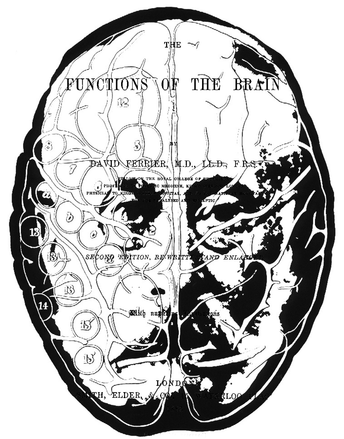David Ferrier1843–1928
Ferrier electrically stimulated the brains of many species and mapped areas of the cortex: “the whole brain is regarded as divided into sensory and motor regions… a scientific phrenology is regarded as possible”. The long-held view that the brain was unaffected by direct stimulation had been overturned by Fritsch and Hitzig in 1870. They electrically stimulated the exposed brains of unanesthetized dogs and found specific precentral areas that resulted in muscular contractions: they divided the cortex into two parts - motor and not motor. Ferrier wrote: “The discovery of new methods of investigation opens up new fields of inquiry, and leads to the discovery of new truths. The discovery of the electrical excitability of the brain by Fritsch and Hitzig has given a fresh impetus to researches on the functions of the brain, and throws new light on many obscure points in cerebral physiology and pathology.” The involvement of certain cortical regions in motor control had been proposed by Hughlings Jackson on the basis of his studies of epilepsy and these, too, were the stimulus for Ferrier’s investigations. In 1873 he commenced a series of experiments at the West Riding Lunatic Asylum on anesthetized frogs, pigeons, guinea pigs, rabbits, cats, dogs, and monkeys in which he applied electrical stimulation to localized areas of the cortex; he also carried out ablations of the same areas. These demonstrated large species differences, and pointed to the dangers of extrapolating broadly, as Flourens had done. Consequently, most attention was paid to stimulation of monkey cortex, and Ferrier described his results in The Functions of the Brain (1876), which was dedicated to Hughlings Jackson. Precise movements of muscle groups followed localized stimulation in the precentral area, sensory defects resulted from more posterior ablation, and lesions in the frontal cortex disturbed intelligent behaviour: “The removal of the frontal lobes causes no motor paralysis, or other evident physiological effects, but causes a form of mental degradation, which may be reduced in ultimate analysis to loss of the faculty of attention.” Ferrier was born in Aberdeen and studied classics and philosophy at its University, where he came under Bain’s influence. After a year at Heidelberg he studied medicine at Edinburgh University. He was appointed professor of forensic medicine at King’s College Hospital, London, and later occupied the specially created chair of neuropathology. With Hughlings Jackson, he was a founding editor of the journal Brain in 1878, and was instrumental in instigating the first surgical removal of a tumour from a human brain. Ferrier is represented in his drawing of the human brain that is marked with the motor map of monkey cortex: the numbers specify localized movements with the letters representing movement areas for the hand and wrist; the title page of his book is also shown.
